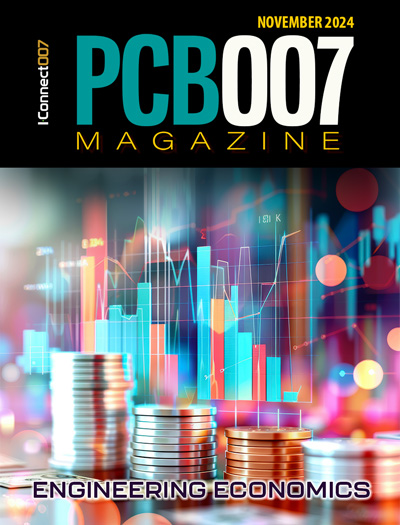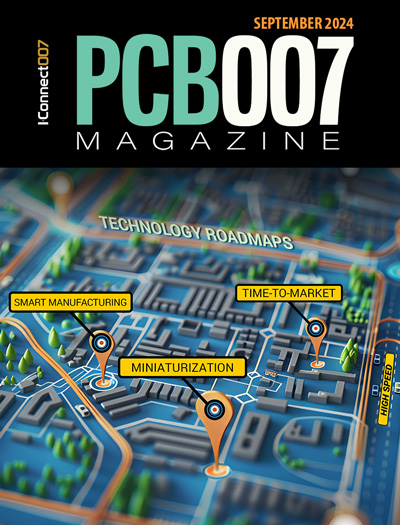-

- News
- Books
Featured Books
- pcb007 Magazine
Latest Issues
Current Issue
Engineering Economics
The real cost to manufacture a PCB encompasses everything that goes into making the product: the materials and other value-added supplies, machine and personnel costs, and most importantly, your quality. A hard look at real costs seems wholly appropriate.

Alternate Metallization Processes
Traditional electroless copper and electroless copper immersion gold have been primary PCB plating methods for decades. But alternative plating metals and processes have been introduced over the past few years as miniaturization and advanced packaging continue to develop.

Technology Roadmaps
In this issue of PCB007 Magazine, we discuss technology roadmaps and what they mean for our businesses, providing context to the all-important question: What is my company’s technology roadmap?
- Articles
- Columns
Search Console
- Links
- Media kit
||| MENU - pcb007 Magazine
TTM Technologies to Exhibit at the Electric & Hybrid Vehicle Technology Expo
July 26, 2017 | TTM Technologies, Inc.Estimated reading time: 1 minute
TTM Technologies, Inc. will be exhibiting at the Electric & Hybrid Vehicle Technology Expo North America 2017 at Booth 1013. The expo runs September 12-14. Technical experts will be available at the booth to answer printed circuit board design, manufacturing, and assembly-related questions. The following key TTM automotive PCB technologies will also be displayed at the booth:
- High-Reliability Applications
- RF/Microwave 24 GHz - 77Ghz +
- Heavy-copper products up to 12 oz. (400 µm)
- Heat sinks (aluminum & copper) and Thermal Management Solutions (TMS)
- High-Volume HDI Capabilities for Advanced Automotive Applications
- Controlled Impedance Applications
- Rigid-Flex and Semi-Flex
- North American Prototyping
“We are exhibiting to support our long-established customer base in the Detroit area and gain insight into emerging technologies that will drive the fast-growing electric and hybrid vehicle market,” said Jon Pereira, President of the Automotive, Medical, Industrial & Instrumentation Business Unit, “We have a broad range of products and services, as well as a global network of engineering and technology experts, that have the ability to bring game-changing technologies to life: printed circuit boards are the heart of the electronic devices that deliver the mobility, communications, entertainment, and safety features people rely on every day.”
About the Electric & Hybrid Technology Expo America
Electric & Hybrid Vehicle Technology Expo is the premier showcase for electric and hybrid vehicle technology and innovation. Based in Detroit, Michigan, the capital of EV manufacturing in America, Electric & Hybrid Vehicle Technology Expo will highlight advances right across the powertrain and across a wide range of vehicles from passenger and commercial to off-highway industrial vehicles. Additional information can be found here.
About TTM
TTM Technologies, Inc. is a leading global printed circuit board (PCB) manufacturer, focusing on quick-turn and volume production of technologically advanced PCBs, backplane assemblies and electro-mechanical solutions. TTM stands for time-to-market, representing how TTM's time-critical, one-stop manufacturing services enable customers to shorten the time required to develop new products and bring them to market. Additional information can be found here.
Suggested Items
Fresh PCB Concepts: PCB Design Essentials for Electric Vehicle Charging
11/27/2024 | Team NCAB -- Column: Fresh PCB ConceptsElectric vehicles (EVs), powered by electricity rather than fossil fuels, are transforming transportation and reducing environmental impacts. But what good is an EV if it can't be easily charged? In this month's column, Ramon Roche dives into the role of printed circuit boards (PCBs) in electric vehicle charging (EVC)—and the design considerations.
Unlocking Advanced Circuitry Through Liquid Metal Ink
10/31/2024 | I-Connect007 Editorial TeamPCB UHDI technologist John Johnson of American Standard Circuits discusses the evolving landscape of electronics manufacturing and the critical role of innovation, specifically liquid metal ink technology, as an alternate process to traditional metallization in PCB fabrication to achieve ever finer features and tighter tolerances. The discussion highlights the benefits of reliability, efficiency, and yields as a tradeoff to any increased cost to run the process. As this technology becomes better understood and accepted, even sought out by customers and designers, John says there is a move toward mainstream incorporation.
Fresh PCB Concepts: The Critical Nature of Copper Thickness on PCBs
10/31/2024 | Team NCAB -- Column: Fresh PCB ConceptsPCBs are the backbone of modern electronics and the copper layers within these boards serve as the primary pathways for electrical signals. When designing and manufacturing PCBs, copper thickness is one of the most critical factors and significantly affects the board’s performance and durability. The IPC-6012F specification, the industry standard for the performance and qualification of rigid PCBs, sets clear guidelines on copper thickness to ensure reliability in different environments and applications.
Book Excerpt: The Printed Circuit Designer’s Guide to... DFM Essentials, Ch. 1
10/25/2024 | I-Connect007The guidelines offered in this book are based on both ASC recommendations and IPC standards with the understanding that some may require adjustment based on the material set, fabricator processes, and other design constraints. This chapter details high-frequency materials, copper foil types, metal core PCBs, and the benefits of embedded capacitance and resistor materials in multilayer PCBs.
The Cost-Benefit Analysis of Direct Metallization
10/21/2024 | Carmichael Gugliotti, MacDermid AlphaCarmichael Gugliotti of MacDermid Alpha discusses the innovative realm of direct metallization technology, its numerous applications, and significant advantages over traditional processes. Carmichael offers an in-depth look at how direct metallization, through developments such as Blackhole and Shadow, is revolutionizing PCB manufacturing by enhancing efficiency, sustainability, and cost-effectiveness. From its origins in the 1980s to its application in cutting-edge, high-density interconnects and its pivotal role in sustainability, this discussion sheds light on how direct metallization shapes the future of PCB manufacturing across various industries, including automotive, consumer electronics, and beyond.


